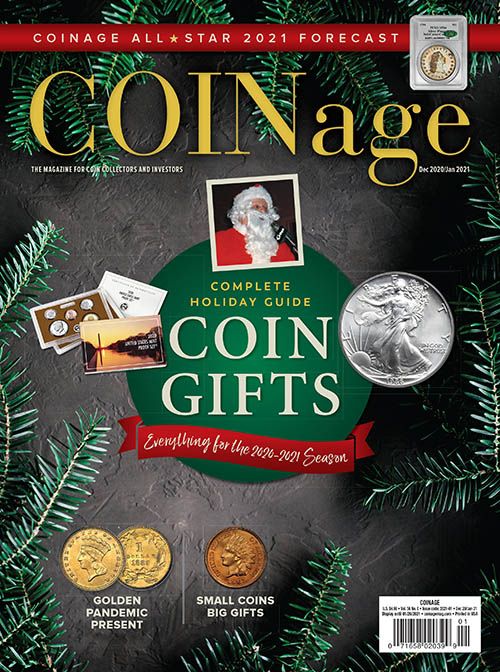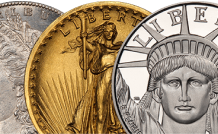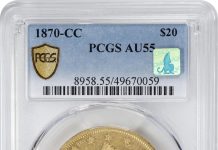
By Greg Reynolds
Editor’s Note: This is first of a two-part series, “Global Turmoil and Coin Market History.” Enjoy Part II >>>
There is similarity in regards to coin markets and coin auctions between the after-effects of the novel coronavirus global pandemic that hit hard in March and April 2020 and the terrorist attacks that occurred on September 11, 2001. In both scenarios, an unexpected and unprecedented crisis caused a national economic disaster, which lead to changes in the scheduling of and participation in coin auctions.
During Spring 2020 and Fall 2001, coin dealers and collectors traveled to a much lesser extent than usual. In September and October 2001, I knew many people who were then terrified of flying on airplanes, and these were people who had previously been accustomed to flying often.
In September 2001, coin auctions in New York were postponed and coin auctions in October and November had a cloud over them. In the June-July 2020 issue of COINage, appeared my coverage of the novel coronavirus and the Pogue VII sale, which was conducted by Stack’s Bowers on March 20, 2020. While the Pogue VII auction was relocated to California because of the cancellation of a coin show that would have occurred in Baltimore in March, the lots themselves, from the epic Pogue Family Collection, had been shown at various locations by Stack’s Bowers for months before the sale. That means prospective bidders, researchers, and other coin enthusiasts had a chance to view the Coins in the Pogue VII sale before COVID-19 became a severe issue.
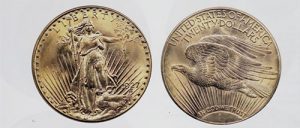
(Sotheby’s)
Auctions and coin shows scheduled for April, May, and June 2020 are a different matter. The shows were canceled. Travel by coin buyers was minimal. The auctions did take place virtually, and prices were lower than they would have been under normal circumstances, partly because it was not convenient for most bidders to see the coins. I am not referring to all bidders. I am speaking about bidders who would have viewed these coins had the novel coronavirus outbreak never happened. The ‘in person’ viewers, especially leading wholesalers, tend to have a substantial effect on the prices realized of any first-tier coin auction.
Recalling Impacts of 9/11
In September, October and November 2001, there was a nationwide environment of fear. Shortly after the terrorist attacks of 09/11/01, President George W. Bush and Vice President Dick Cheney ended up in geographically distant, heavily fortified military bunkers. In the national media, there was endless discussion of vulnerabilities and counter-measures.
On 09/12/01, I was startled by U.S. fighter jets buzzing about New York City at low altitudes. There were military troops on the ground, too, and many police officers brought to Manhattan from throughout the State of New York. Someone walking around could easily be under the impression that New York City was under martial law, though this was never really true. However, the vast majority of people walking around were in some kind of military or law enforcement uniform. My ordinary clothes caused me to stand out.
People then were afraid that the terrorist attacks of 09/11/01 were the first wave of many to come. Is that nationwide fear then parallel to the fear now that outbreaks of novel coronavirus could resurge if the economy re-opens soon or the fear that there could be outbreaks of other superviruses in the near future?
By 2005, the economic disaster and climate of fear resulting from terrorist attacks on 09/11/01 were largely forgotten. Except for airport security and banking practices, business and social behavior patterns had returned to normal, very similar to what they were before September 11, 2001. Four years from now, will the markets for rare coins and coin auctions have returned to normal, as they were before 2020?
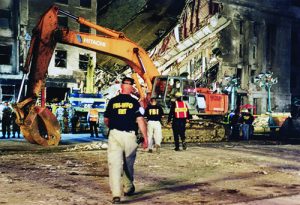
(US Federal Bureau of InVestigation)
As the nation recovered from the after-effects of 09/11/01, so will the nation recover from the after-effects of the outbreak of the novel coronavirus (COVID-19). Coin buyers and people in general who are upset and scared in the present may not remember that the terrorist attacks of 09/11/01 were far more alarming. The United States was literally attacked, and thousands of people were killed during one morning. The two primary World Trade Center buildings in New York were destroyed by suicidal terrorists who hijacked ordinary passenger planes.
The Pentagon in Arlington, Virginia, was attacked as well. The Pentagon houses the headquarters of the U.S. Department of Defense. The Secretary of Defense and the nation’s highest-ranking military officers have offices there, as well as many other military officers and key civilian support personnel. Ironically, construction of the Pentagon began on September 11, 1941, sixty years before the terrorist attack on September 11, 2001, which destroyed much of the building and killed many government employees along with all of the people on the hijacked airliner.
Understanding How Locale Has An Impact
While the outbreak of the novel coronavirus is probably unintentional, the attacks on September 11, 2001 were certainly the work of Al-Queda, a notorious terrorist organization that at the time was based in Afghanistan. In the fall of 2001 and the spring of 2020, U.S. citizens feared that their way of life was irreparably damaged, and coin owners were concerned about the effects on coin markets. The World Trade Center was symbolic of the prestige and international role of New York City, and the World Trade Center site is extremely close to the heart of the financial community. Stock exchanges, top brokerage firms, some leading trading funds, and major investment banks are or were located nearby.
In 2001, New York played a much greater role in the coin business than it did in 2019. Indeed, New York was then the center for coin auctions and the location of many coin conventions. In 1997 and again in 2002, the summer ANA Convention took place in New York. The winter FUN Convention in Florida was nowhere near as important in the 1990s as it would become, especially after 2004. The FUN auctions were then secondary to many of the coin auctions in New York City. Not all major coin auctions were then held in New York, but New York was clearly the coin auction capital.
As late as 2015, Heritage held major auctions of U.S. coins in New York. Indeed, twice in 2014 and twice in 2015, Heritage conducted sales of the Gene Gardner Collection in New York, which was the all-time best collection of Liberty Seated coins and featured landmark sets in other areas. In my opinion, Gene had the best set of Barber quarters that was ever publicly auctioned. Additionally, while some portions of Eric Newman’s collection were auctioned elsewhere, the most important sales of U.S., colonial and world coins from this collection were conducted in New York in 2013 and 2014. I covered the Newman auctions in great detail for an online publication.
From the 1940s to 2001, New York was really the happening place for
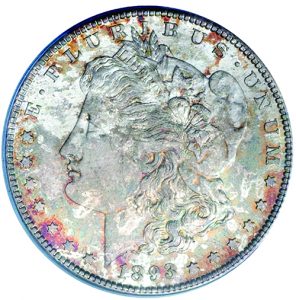
(Stack’s Bowers)
coin auctions, except for the annual summer ANA auctions, which were held at various locations around the nation. During the 1990s, the leading auction firms were Bowers & Merena of New Hampshire and Stack’s of New York, which were then separate. Stack’s conducted almost all of its auctions in New York. Bowers & Merena then held most of its major sales in New York.
During the 1990s, Sotheby’s was a major player in the coin auction business. Christie’s was a player, too. Sotheby’s and Christie’s conducted sales of U.S. coins in New York. The auctions by Sotheby’s of the Gene Reale Collection in January 1998 and the John Moores Collection in November 1999 come to mind, amazing collections that have become largely forgotten. During that era, Christie’s sometimes employed the name “Spink America.” The sale of a large part of the Byron Reed Collection in October 1996 at Christie’s headquarters in New York was one of the most important sales of the decade.
The most important coin auctions of the 1990s were the two Eliasberg sales by Bowers & Merena at the St. Moritz Hotel on Central Park South in May 1996 and April 1997. Although Eliasberg’s U.S. gold coins had already been auctioned in October 1982, with some other Eliasberg Collection coins sold during the following decade, most of the famous U.S. coins and patterns in the Eliasberg Collection were in these two sales. Louis Eliasberg, Sr. formed the all-time greatest collection of U.S. coins. ANR auctioned Eliasberg’s world gold coins in New York in April 2005. By then, hardly anyone was talking about 9/11.
If you enjoyed what you’ve read here we invite you to consider signing up for the FREE COINage Connection e-newsletter. Learn more>>>
In addition, we invite you to consider subscribing to COINage magazine. The cost for a one-year U.S. subscription (6 issues) is $24.95. Learn more >>>


